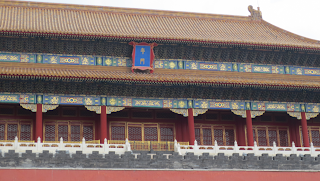Beijing
Much of the travel that we will do in the city will be by bus.
It’s been a while since I have been on a bus so I don’t remember if all buses
have horrific fumes or if it is the gas that is used here that makes this bus
so smelly but I try to keep my mouth closed while traveling—yuck!
This is one of the remaining gates, complete with guard,
from the wall that once surrounded the city.
There are two portions of the wall remaining;
this is one of them.
Tiananmen Square
Our first stop was Tiananmen Square. The Tiananmen Gate to the Forbidden City was built in 1415 during the Ming Dynasty; the Square was not built until 1651 and over the course of time has quadrupled in size. This site is a common meeting place as well as a ceremonial site; it has been the site of political events as well as student protests. It is the location for Chairman Mao’s announcement of the creation of a new China on October1, 1949.The Chinese people have a great respect and love for Mao, something that is very hard for Americans to understand. They say that Americans have no idea of what China was like prior to Mao’s arrival on the scene. It is also the site of the 1976 and 1989 protests which resulted in suppression and the deaths of many protestors. The Communist Party forbids discussion of the Tiananmen Square protests.
The opening above Mao's picture is the spot where he declared the
formation of the People's Republic of China in 1949.
Here's a close-up of the speech location.
Monument to the people
The Forbidden City
Entrance to the Forbidden City
Next we visited The Forbidden City. This is where the
emperor and his households lived and it is the heart of the city. It was also
the ceremonial and political center of Chinese government. It was the Chinese imperial palace from the Ming
Dynasty (1368-1644) to the end of the Qing Dynasty (1644-1912). Construction on The Imperial Palace began in 1406 and was completed in 1420. More than one milion workers were needed to complete the work. The complex consists of 980 buildings. It is exquisite
and is an example of the ancient Chinese architectural style that is seen
throughout Old Beijing. In 1925 it was established as the Palace Museum.
This was the 'home-school' for the young emperor.
These cauldrons were placed in the city to collect water; they were originally gold plated. During the second opium war in 1860 the Anglo-French invaders scraped the gold off and harvested it.

Details of a roof in the Forbidden City.
The throne in the palace.
Beijing Urban Planning Exhibition
Our final stop before dinner was the Beijing Urban Planning Exhibition. When I saw this on the itinerary I couldn’t imagine what it was or why it would be of interest to a tourist. I was quite astonished when we actually entered the building and saw the various stages of the city’s development. There were models, a huge floor layout of the city with an accompanying laser show that lit up the portions of the model that were being discussed on the screen. Very cool.
The model of the city that accompanied the laser show.
The lit blue square is the Forbidden City, the seat of the Ming Dynasty from 1420-1644.Today the Chinese refer to it as the "Former Palace". It had been the home of 24 emperors--14 Ming and 10 Qing.
A different model of the city.
The lit blue square is the Forbidden City, the seat of the Ming Dynasty from 1420-1644.Today the Chinese refer to it as the "Former Palace". It had been the home of 24 emperors--14 Ming and 10 Qing.
A different model of the city.
Who are all of these famous people on the city streets?
A typical dinner setting



















No comments:
Post a Comment